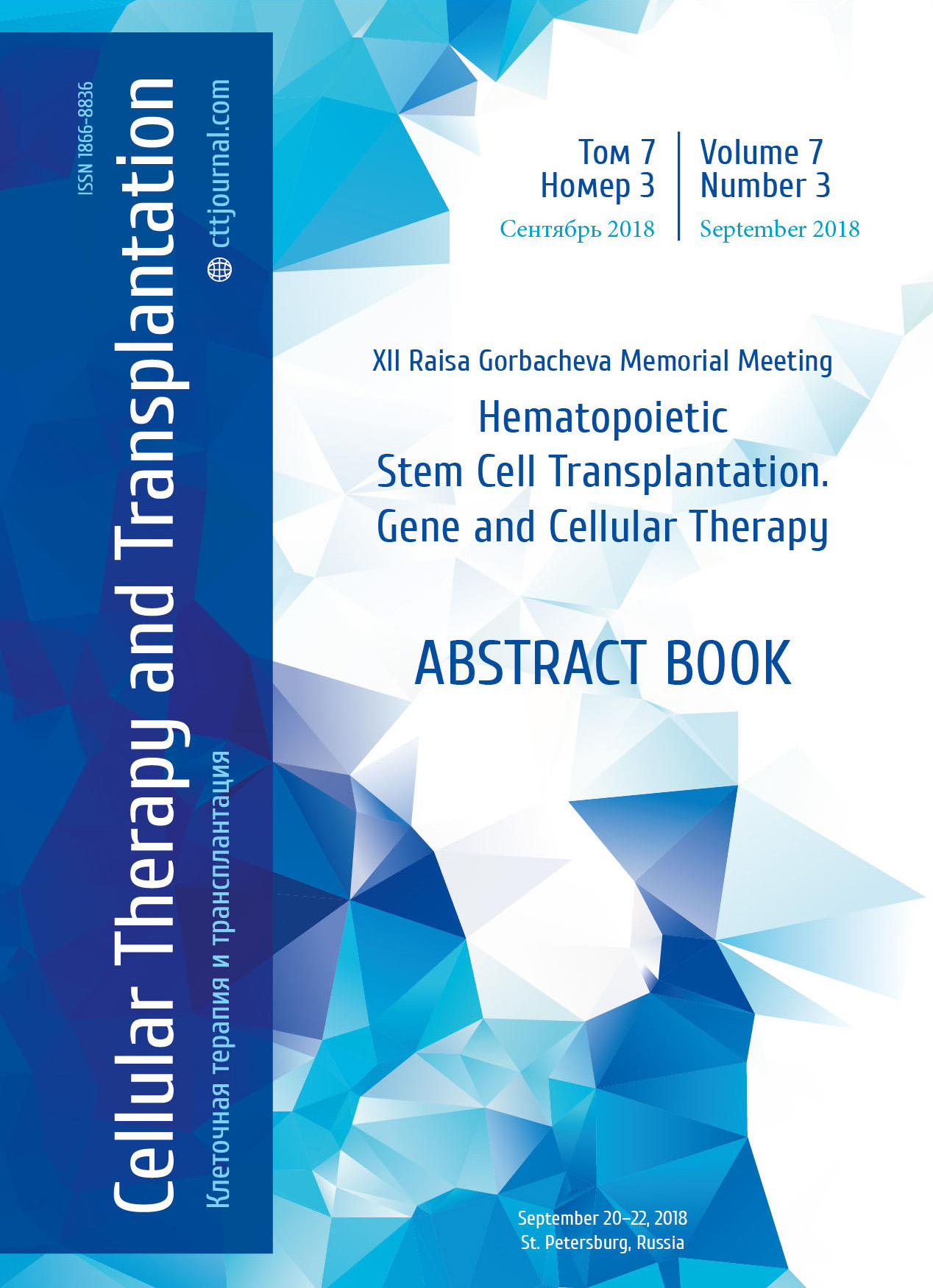Recovery of memory T cells after alternative prophylaxis regimens of acute graft-versus-host disease (aGVHD) in leukemia patients after allogeneic stem cells transplantation
Summary
Introduction
T-memory cells form the heterogeneous pool of immune cells responsible for alloreactivity after allogeneic stem cells transplantation (allo-HSCT). Nowadays there are new different approaches for aGVHD prophylaxis, but the unified immunosuppressive regimen has not been defined yet. Obviously the immunosuppressive therapy as aGVHD prophylaxis is essential to control aGVHD especially in terms of mismatched or haplo-HSCT when strong immunoablation is required. But timely immune reconstitution is crucial for antitumor immunity. Aim of the present study was to evaluate an impact of different immunosuppressive regimens of aGVHD prophylaxis on T-memory cell subsets recovery in leukemia patients after allo-HSCT.
Patients and methods
The study comprised 39 leukemia patients with a median age of 36 years old (17-60 y.o.) who underwent allo-HSCT in National Research Center for Hematology, Russia. Alternative immunosuppressive regimens of aGVHD prophylaxis in case of mismatched or haplo-HSCT (n=17) include Posttransplant high dose Cyclophosphamide (PT-Cy) on day +3, +4 or alfa/beta T-cells depletion in young patients. Classical immunosuppressive regimen with CsA+MMF+MTX was applied in case of matched related and matched unrelated donors and form the control group (n=22). The characteristics of patients, immunosuppressive regimens, aGVHD and relapses after allo-HSCT are presented in the table 1. Samples of peripheral blood were collected on day +30, +60 and +90 after allo-HSCT in EDTA-tubes. Flow cytometry analysis was performed on BD FACS Canto II (Becton Dickinson, USA) to define T-memory subsets: T-naive and T-stem cell memory (Tnv+Tscm) – CD8+/CD4+ CD45R0-CCR7+CD28+; T-central memory (Tcm) – CD8+/CD4+ CD45R0+CCR7+CD28+; T-transitional memory (Ttm) – CD8+/CD4+CD45R0+CCR7-CD28+; T-effector memory (Tem) – CD8+/CD4+ CD45R0+CCR7-CD28-; T-terminal effector (Tte) – CD8+/CD4+ CD45R0-CCR7-CD28-. Mann-Whitney U test was used for nonparametric data analysis. A p-value less than 0.05 was considered as significant. All data analysis was conducted utilizing SPSS ver. 23. (IBM, Chicago, Ill., USA).
Results
The data are presented in the Fig. 1. According to our data, absolute number of CD8+ Tnv+Tscm after classic immunosuppressive regimen was significantly higher than after PTCy prophylaxis, or T-cells depletion on days +30, +60, +90. Absolute number of CD8+ Tnv+Tscm after classic immunosuppressive regimen on day +30 was 4.22 cells/μL (1.21-7.0 cells/μL), after PT-Cy – 0.38 cells/μL (0.17-0.63 cells/μL) (p=0.001), after Т-cell depletion – 0.14 cells/μL (0.05-0.15 cells/μL) (р=0.03). Appropriate levels by the day +60 were 2.57 cells/μL (1.49-4.99 cells/μL) after classic immunosuppressive regimen; 0.12 cells/μL (0.02-0.15 cells/μL), after Т-cell depletion; 1.1 cells/μL (0.72-2.8 cells/μL) after PT-Cy (p=0.009). On the day +90 these parameters were 4.29 cells/ μL (2.08-6.58 cells/μL) after classic immunosuppressive regimen; 1.82 cells/μL (0.16-3.3 cells/μL) after PT-Cy; and 0.35 cells/μL (0.01-0.7 cells/μL) after Т-cell depletion (p=0.035). On day +30 and +60, absolute numbers of CD8+ Tcm were significant lower after alternative approaches, when compared to classical immunosuppressive regimen, i.e., on day +30, 1.07 cells/μL (0.27-1.75 cells/μL) after classical regimen; 0.25 cells/μL (0.12-0.68 cells/μL) after PT-Cy (р=0.032); 0.18 cells/μL (0.01-0.34 cells/μL) after Т-cells depletion (р=0.036); on day +60, 0.9 cells/μL (0.65-1.68 cells/μL); 0.42 cells/μL (0.33-0.73 cells/μL); 0.05 cells/μL (0.01-0.07 cells/μL), respectively (р=0.02). Absolute number of CD4+ Tnv+Tscm on day +30 was significantly higher after classic immunosuppressiveregimen, i.e. 16.1 cells/μL (2.1-55.0 cells/μL), as compared to PT-Cy – 1.35 cells/μL (0.7-5.36 cells/μL), and Т cell depletion – 0.31 cells/μL (0.27-0.71 cells/μL) (р=0.05). Absolute number of Тtm CD8+ on days +60, +90 and CD4+ on day +30 were different in alternative aGVHD prophylaxis and in control group (Fig. 1). We didn’t find any correlations between absolute numbers of Tnv+Tscm, Tcm, Ttm, Tem, Tte and aGVHD onset, or leukemia relapse after allo-HSCT.
Conclusion
Tnv+Tscm is the progenitor subset for all memory and effector T-cells and its prompt recovery after allo-HSCT seems to be crucial for graft-versus-leukemia effect. Here we show the lowest number of CD4+/CD8+ Tnv+Tscm, CD8+ Tcm after alternative approaches of aGVHD prophylaxis that might reflect sever immunoablation in mismatched or haplo-HSCT. To this point, low numbers of Tnv+Tscm on day +60, +90 as progenitor cells for the whole T-memory pool may lead to delayed reconstitution of adaptive immunity after alternative aGVHD prophylaxis in patients after allo-HSCT.
Disclosures
No relevant conflicts of interest to declare.
Keywords
Memory T cells, immune reconstitution, allogeneic stem cell transplantation, GVHD prophylaxis regimens.
Table 1. Characteristics of the patients


Figure 1. Recovery of T-memory cell subsets in terms of different GVHD prophylaxis in leukemia patients after allo-HSCT
Significant differences (p<0.005) between the number of different T-memory cell subsets in terms of alternative GVHD prophylaxis – PT-Cy or T-cells depletion comparing to classic immunosuppressive regimen are presented in the graph.


